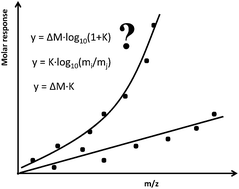A simple procedure to select a model for mass discrimination correction in isotope dilution inductively coupled plasma mass spectrometry
Abstract
A fast, simple and straightforward procedure to decide on the best model to calculate the mass discrimination factor in Isotope Dilution Inductively Coupled Plasma Mass Spectrometry (ID-ICP-MS) is proposed. It is based on the study of the residuals of the different models that are proposed commonly, viz., the linear, the exponential, the power and Russell's models. However, it can be generalized to evaluate any model proposed to linearize the relationship between the theoretical/measured isotope ratios and the mass. The procedure does not involve laboratory extra work, it is rooted on basic statistics associated with the least squares fit, and can be applied easily by the analysts so that decision making is fast and reliable. The procedure was exemplified with four different examples where Cd, Cr, Nd and Sm were determined by ID-ICP-MS.


 Please wait while we load your content...
Please wait while we load your content...